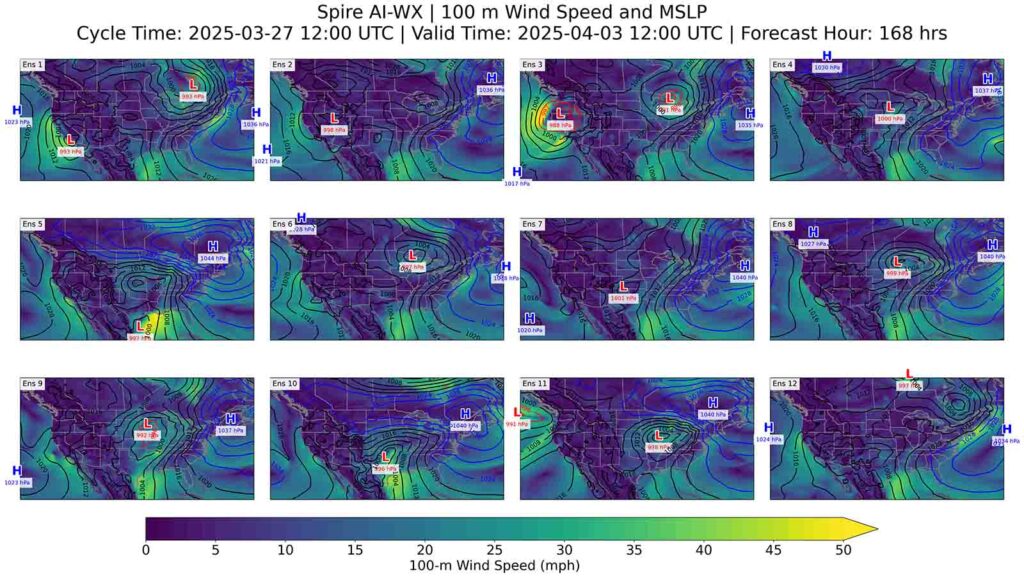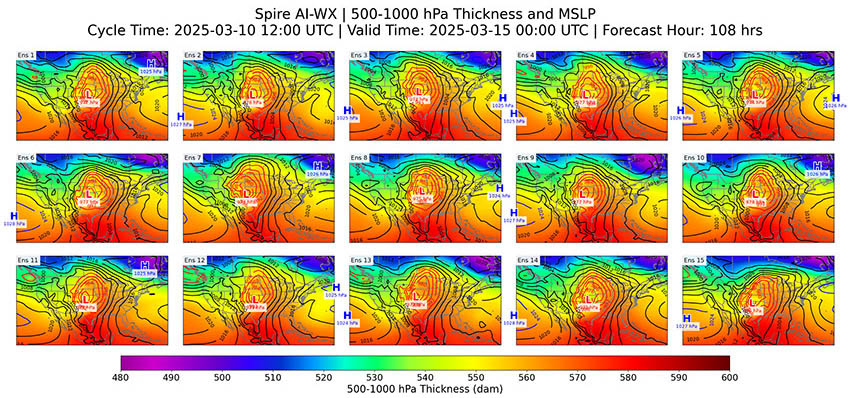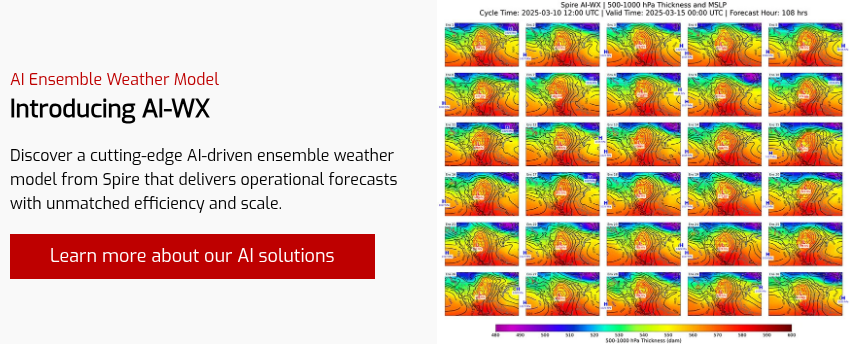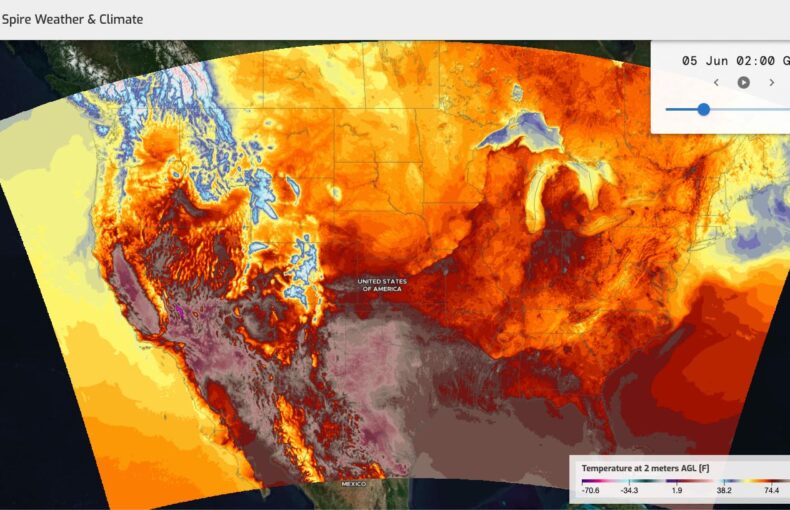Introducing Spire’s AI-WX: the ensemble model that will redefine medium-range weather forecasting
- Harnessing AI for medium-range weather forecasting
- The power of 30 ensemble members for probabilistic risk analysis
- Spire's proprietary data advantage with AI-driven medium-range weather forecasting
- AI-WX is built for real-world impact and industry applications
- Effortless integration into business workflows and stunning visualization
- Spire's AI model roadmap for the future
Spire’s AI Ensemble Weather Model (AI-WX) leverages exclusive satellite-derived data and global DA, producing accurate medium-range forecasts ideal for trading, agriculture, utilities, and logistics.
From energy trading to supply chain optimization, businesses today need more than accurate medium-range weather forecasts—they need probability-driven insight to stay ahead of disruption and gain a competitive edge. That’s exactly what Spire’s new AI-driven ensemble weather model, AI-WX, is designed to deliver.
AI-WX is among the first fully operational AI-powered ensemble weather models in the commercial market. It provides global forecasts with a 20-day outlook and runs with a 30-member ensemble, offering a robust probabilistic foundation for weather-sensitive industries.
What sets AI-WX apart isn’t just that it uses artificial intelligence—it’s how it uses it: combining cutting-edge model architecture with Spire’s proprietary satellite observations and a powerful data assimilation system.
Harnessing AI for medium-range weather forecasting
Spire’s AI-WX leverages deep learning techniques to perform global weather forecasting with exceptional speed and scalability. Rather than relying solely on traditional numerical weather prediction (NWP) models, which are expensive and time-consuming to run, AI-WX uses one of the world’s top-performing open-source AI models adapted with Spire’s proprietary data to generate forecasts far more efficiently.
“Training an AI model can be resource-intensive, but once it’s trained, running a forecast—or inference—is dramatically cheaper,” said Dr. Luis Vela, Spire’s Senior AI Weather Scientist. “In some cases, inference is up to 1,000 times more efficient than traditional NWP. That cost savings opens the door to running more ensemble members, which means better forecasts.”
Where traditional NWP systems often rely on CPUs and are limited by hardware constraints, AI-WX is optimized for NVIDIA GPU-based acceleration. This not only improves computational efficiency but also enables frequent model updates—AI-WX runs four times a day, delivering fresh forecasts for every six hours out to 20 days.
AI-WX operates at 0.25° resolution (~25 km grid), capturing localized conditions with global scale—ideal for both regional and international operations.

Spire’s AI-WX forecast initialized on March 27, 2025, at 12z shows 12 ensemble forecasts for 100-m wind speed and mean sea level pressure predictions on April 3, 2025 (168 hours in advance). AI-WX has 30 ensemble members operationally.
The power of 30 ensemble members for probabilistic risk analysis
At the heart of AI-WX is its ensemble-based design. With 30 members per forecast run, the model provides a probabilistic view of the future atmosphere, rather than a single deterministic scenario. This probabilistic approach enables businesses to quantify uncertainty, assess risk, and make more informed decisions.
“You’re not just getting one outcome—you’re getting 30 possible futures,” said Dr. Vela. “If they cluster tightly, confidence is high. If they spread out, there’s more uncertainty. This is especially valuable in industries where wrong decisions have real costs.”
Unlike many AI models that assume a simple Gaussian distribution (bell curve), AI-WX can capture more complex patterns, including bimodal outcomes. This added insight helps users interpret extreme or less likely scenarios that could otherwise be missed.
“Instead of saying ‘this will happen,’ we say: ‘here are 30 ways it could play out, and here’s how likely each scenario is.’ That’s the future of forecasting,” Vela added.
Spire’s proprietary data advantage with AI-driven medium-range weather forecasting
What makes AI-WX stand out among emerging AI models is the quality of its input data. Spire operates one of the only commercial global data assimilation (DA) systems and feeds the AI-WX model with exclusive GNSS radio occultation (RO) data collected from its proprietary satellite constellation.
“AI forecasting is only as good as the data that feeds it. That’s why we’ve built our model on a top-tier open-source AI framework—but powered it with Spire’s own satellite data,” said Dr. Tom Gowan, Spire’s Director of Weather Prediction and AI. “Our data assimilation system integrates this high-resolution observational data, improving the accuracy of the forecasts.”
Spire’s DA system is a key differentiator in an industry where high-quality initial conditions often make the difference between a good forecast and a great one.
AI-WX is built for real-world impact and industry applications
While most AI-based models offer forecasts out to 10 or 15 days, AI-WX extends the horizon to 20 days. This longer lead time is particularly important for sectors requiring medium-range planning, such as agriculture, energy, and supply chain logistics.
Additionally, AI-WX was developed not as a research tool, but as an operational forecasting product, designed to solve real-world business challenges. Its probabilistic approach and rapid update cycle are already showing strong value across several sectors:
- Energy and commodity trading: Probabilistic forecasts help traders hedge risk more effectively by providing confidence ranges around temperature, wind, and demand-driven variables
- Agriculture: Farmers gain better insight into frost risk, rainfall variability, and planting conditions well ahead of time
- Supply chain and logistics: Companies can optimize routes and operations by quantifying uncertainty in wind, precipitation, or extreme events
- Utilities and infrastructure: Operators benefit from longer-range planning tools for maintenance scheduling and load forecasting
“Forecasting is just the start. The real value is in translating weather data into business decisions—like hedging strategies or power grid adjustments,” Dr. Vela explained, adding that the Spire DeepVision™ Weather Support Team is talented and skilled at providing weather risk assessments and tailored forecasting services.
With hurricane season approaching, Spire’s clients are also turning to AI-WX for extreme weather risk management. Ensemble models are especially valuable in tracking potential hurricane paths and understanding where uncertainty is highest.

Spire’s AI-WX forecast initialized on March 10, 2025, at 12z shows 15 ensemble forecasts for 500-1000 hPa thickness and mean sea level pressure predictions on March 15, 2025 (108 hours in advance). AI-WX has 30 ensemble members operationally.
Effortless integration into business workflows and stunning visualization
AI-WX will be accessible via API and Spire’s Cirrus visualization platform, making it easy to incorporate into existing workflows or explore forecasts visually. Users can access raw ensemble data or post-processed summaries, including ensemble means, percentiles, and full distributions.
Spire is also building out features such as anomaly detection, MJO forecasts, and backcasts—tools that will provide even deeper insights into atmospheric patterns and trends.
Spire’s AI model roadmap for the future
AI-WX is just the beginning. Spire’s long-term vision includes building entirely new AI models from the ground up, much like Spire’s AI-S2S model, and training directly on raw satellite measurements. By bypassing traditional data assimilation workflows, this approach could unlock even faster, more scalable forecasting, with even more frequent forecast updates.
“Our AI ensemble model takes global forecasting to the next level, processing vast amounts of atmospheric data every six hours. By running one of the first fully operational AI weather ensembles, we are delivering fast, accurate, and scalable weather intelligence for our customers.”
Share on Facebook Share on Twitter Share on LinkedIn
With its foundation of proprietary data, efficient architecture, and ensemble intelligence, AI-WX represents a significant advancement in AI-driven weather prediction. Moreover, it’s designed not just to forecast weather in the medium range, but to help businesses better plan for it.
“We own the satellites. We produce the data. And we have the infrastructure to do something no one else in the market can,” said Dr. Vela. “This is our opportunity to redefine how weather forecasting is done.”
 Written by
Written by Mike Eilts
Mike Eilts



